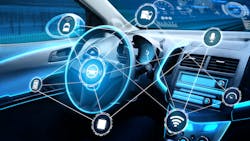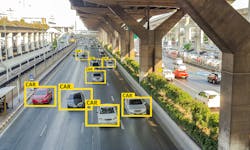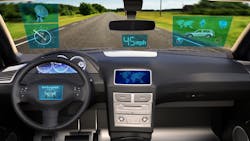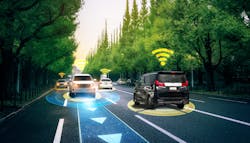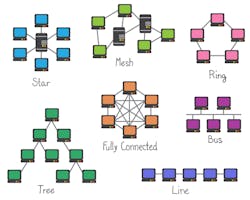Content brought to you by Motor Age. To subscribe click here.
What you will learn:
• ADAS is a series of subsystems that vary between vehicle configurations
• ADAS provides "assistance" to the driver, but is not meant to replace driver input
• Understanding how the individual components function will aid in diagnosis
When it comes to ADAS (advanced driver assistance systems), the first things that likely come to mind for most technicians and consumers are radar cruise control and lane watch. But ADAS is much more than that. As the name indicates, it is a system.
These systems are made up of sub-systems that consist of individual components; and not every vehicle is configured the same way. Rather than getting overwhelmed with the ins and outs of ADAS, we can simply visit it, one component at a time. Hopefully, I can clear up and dispel some of the myths that keep a lot of us at bay.
The pieces of the ADAS puzzle
ADAS is a series of sub-systems that work together to ensure the driver and occupants of the vehicle, as well as the other vehicles and pedestrians nearby, can operate safely together on our network of roads and highways.
ADAS came to be as its implementation led to far fewer accident-related injuries, and far more lives spared. When it comes to safety, it’s the combination of the onboard ECUs (electronic control units) processing power, as well as the capable speed (or baud rate) of the networks in which the data is shared, that allows the reaction time (to a potential safety issue) to be far swifter than that of us human beings.
With that, it’s a no-brainer that the NHTSA (National Highway Traffic Safety Administration) has mandated that all new vehicles possess certain subsystems of ADAS. And as these systems continue to become more prevalent, the everyday jobs we have performed for decades will now require ADAS system calibration to operate safely — and you are the one to be held responsible for that calibration, regardless of how you choose to handle it.
So, the questions become, “Why are so many of us hesitant to get involved in the diagnosis, repair, and calibration of ADAS?” After all, it can no longer be avoided. Why should we continue to farm out the calibrations to the dealerships and mobile technicians? It is not only possible to do in-house (in most situations) but also be a phenomenal source of revenue as well.
Like anything else, ADAS simply takes a level of understanding. If we can determine the different subsystems available that make up ADAS, identify each of the components that make up these subsystems, and learn how each of those component's function, we should have a much better understanding of how to address ADAS challenges when they arise. One thing to keep in mind is that any ADAS subsystem is designed to supplement and assist drivers — it is not intended to replace the drivers. If the calibration is not proper, the response from the ADAS systems will not be either.
ADAS uses a combination of different systems, and these combinations vary from vehicle to vehicle. Some of the components below provide input to the subsystems that make up ADAS, and we will visit them individually:
-
Image processing cameras
-
Radar
-
Lidar
-
Ultrasonic sensors
-
Electromagnetic sensors
Image processing cameras
These cameras serve as the “eyes” of the ADAS subsystems (Figure 1). They provide input to the lane departure warning subsystems or Lane Keep Assist (LKA), helping to keep the vehicle on its intended path between the painted lines on the road. These cameras also provide input to assist in parking the vehicle and preventing contact between two vehicles or other stationary objects. They can even begin to recognize road signs and such, giving the system some artificial intelligence.
Light detection and ranging (lidar):
These systems use pulsed laser light to illuminate an object in its path and measure the distance (Figure 2). The interpretation of this pulsed laser light is seen by the processing computer as a 3-D image. It’s this technology that allows autonomous vehicle features to function without driver input. This system is what provides for collision avoidance and what is known as braking mitigation, meaning if the vehicle got too close to one in front of it, the vehicle could apply the hydraulic brakes, increasing the distance between the two vehicles and/or reducing the rate of approach.
Radio detection and ranging (radar):
This system detects objects using radio waves. It can accurately detect the range, angle, and/or velocity of objects by interpreting these casted radio waves (Figure 3). These systems work to provide similar detecting capabilities as the cameras but allow for cross-traffic alerts. For instance, if a child was intending to fetch a ball that rolled into the street, the short or medium-range radar system would detect him/her and alert the driver. These radar systems provide for blind spot detection, alerting the driver to a possible collision if a lane change were to occur at an inappropriate time. The short/medium-range radar system will help prevent rear-end collisions from occurring in parking lots and such, during reversing.
Another version of radar is used for longer ranges. The long-range radar is ideal for systems like adaptive cruise control (ACC). Allowing the vehicle to slow down when approaching the vehicle ahead of it at too high a rate of speed. This system will maintain a safe distance (selectable by the driver) from the vehicle ahead and can even resume the chosen speed/distance after stopping at a traffic light.
Ultrasound
Using ultrasonic proximity sensors, the distance between the vehicle and objects within close proximity can be detected, allowing the vehicle to get close to the other vehicles during parking maneuvers, but without contact (Figure 4). These sensors emit higher frequency noise (undetectable to the human ear and at a speed of over 340 meters per second!) and listen for the echo to return. As the detected object nears the vehicle, an audible warning is sent to the driver. The closer the object becomes, the more frequent the audible warning becomes. Just prior to contact being made, the audible tone becomes steady, alerting the driver to stop approaching. These sensors can be found both in the front of the vehicle as well as the rear. It’s this same technology that we see implemented in the vehicles with liftgates, allowing an opening without contact (waving your foot in the path of the sensor’s view).
Electromagnetic parking sensor
Very similar to the ultrasonic sensor, these sensors provide input to support similar capability; they simply just function differently. The input from these sensors will not only allow for an audible warning (when a detected object is within close proximity) but can also allow for brake mitigation (more on that, shortly).
Each one of these systems can offer either a passive response to the driver (a simple audible or haptic warning) such as the vibration of the steering wheel or the driver’s seat frame, or an active response (a corrective action) such as steering correction or braking mitigation. Sometimes the vehicle allows for a selectable response or even for the system to be turned off entirely.
A true network
Each of those components can be associated with more than one system. We refer to that as sensor fusion. Because the information is communicated between multiple ECUs on the network, sensor fusion becomes possible, allowing for shared responsibility (Figure 5). For instance, combining images from forward-facing cameras, backup cameras (and possibly others) allow for an around-the-vehicle view and even gives the vehicle the ability to display an image (to the driver) that seemingly sees straight through a pull-along trailer, connected to the vehicle. Or using inputs from both the lidar and forward-facing camera to determine the need for braking mitigation to avoid a rear-end collision. This same sensor fusion also allows for autonomous parallel parking, appearing as magic has occurred. Another example would be for the wheel speed sensors, yaw sensor, steering angle sensor, front camera input and GPS, to allow for proper compensation of the active headlamps at the appropriate time, preventing blinding of an oncoming car/driver, and increasing illumination in the direction the steering wheel is turned (input from the steering angle sensor).
Sensors provide the inputs, and the processed inputs allow the ADAS to make decisions about the appropriate output. Inputs like the ones below are used to operate and monitor the active responses:
-
Instrument panel cluster (serving as a gateway)
-
Throttle position sensor (for speed control)
-
Wheel speed sensors (to detect wheel slip during braking mitigation and acceleration for ACC)
-
Yaw sensors/accelerometers (to prevent loss of control during active responses)
-
Steering angle sensor (monitoring the actual and feedback for active responses like LKA)
-
Brake pedal position sensor (to determine driver’s intent to stop)
Mastering the basics
This is the easy part. All the components of all the subsystems of ADAS need just a few things to function properly: an adequate voltage supply, ground supply, ignition voltage supply, and a means to communicate with the other nodes on the networks. This is no different than analyzing any other computerized system you were faced with in the past. It simply requires access to service information, so you can understand how the vehicle you are addressing is configured.
Once that is known, research can be performed to determine what subsystem the subject vehicle has. When it comes to repairing or replacement, it’s always recommended to do the research ahead of time. Being physically and mentally capable of completing a repair isn’t enough. Having the proper tooling and access to software is what it takes to complete the job correctly, and on the first visit.
Regarding ADAS calibration, there are two forms (static calibration and dynamic calibration). Some systems on some vehicles require one or the other. Some require either of the two, and some require both. Being prepared and tooled appropriately can make ADAS calibration very profitable.
Capitalizing on the technology
Many of mobile technicians provide service solutions to the surrounding collision and repair shops in their areas. Some have created ADAS supercenters for themselves. They have the necessary space, calibration equipment, proper lighting, and software to carry out the calibrations for most auto manufacturers, without any issues.
The profitability doesn’t only come from the fact that they are properly equipped and can complete the jobs they encounter efficiently, much of it comes from advertising. They have put the word out around town to all the local collision repair shops and insurance companies. They have adequate parking to house all the upcoming jobs as well as a dedicated alignment rack solely for ADAS jobs. This, in combination, makes for a very streamlined and profitable business within a business.
Of course, I’m not here to convince anyone how they choose to run their business. However, I would like to instill some confidence. Venturing into the world of ADAS may seem like an expensive one, but we’ve been down this road more than once. If you can simply consider that every vehicle that requires alignment will require an ADAS calibration (assuming it is equipped with radar), it should be clear to see that with only a few calibrations monthly, the ADAS calibration system will pay for itself in a very short amount of time. Also, by 2025, all light-duty passenger vehicles up to 10,000 lbs will be required to implement standard automatic emergency braking. This will make the return on investment huge.
But don’t take my word for it. Do your own research on the available systems. Take the time to figure out how many alignments you are currently doing per month. Figure out a way to reach out to the local collision repair facilities. After all, they must be getting the calibrations completed somewhere; why couldn’t it be in your new ADAS supercenter? Trust me when I say that ADAS is not going away. It’s only going to become more prevalent as time passes. Jump on the train while it’s passing you; don’t wait until it's gone.
About the Author
Brandon Steckler
Technical Editor | Motor Age
Brandon began his career in Northampton County Community College in Bethlehem, Pennsylvania, where he was a student of GM’s Automotive Service Educational program. In 2001, he graduated top of his class and earned the GM Leadership award for his efforts. He later began working as a technician at a Saturn dealership in Reading, Pennsylvania, where he quickly attained Master Technician status. He later transitioned to working with Hondas, where he aggressively worked to attain another Master Technician status.
Always having a passion for a full understanding of system/component functionality, he rapidly earned a reputation for deciphering strange failures at an efficient pace and became known as an information specialist among the staff and peers at the dealership. In search of new challenges, he transitioned away from the dealership and to the independent world, where he specialized in diagnostics and driveability.
Today, he is an instructor with both Carquest Technical Institute and Worldpac Training Institute. Along with beta testing for Automotive Test Solutions, he develops curriculum/submits case studies for educational purposes. Through Steckler Automotive Technical Services, LLC., Brandon also provides telephone and live technical support, as well as private training, for technicians all across the world.
Brandon holds ASE certifications A1-A9 as well as C1 (Service Consultant). He is certified as an Advanced Level Specialist in L1 (Advanced Engine Performance), L2 (Advanced Diesel Engine Performance), L3 (Hybrid/EV Specialist), L4 (ADAS) and xEV-Level 2 (Technician electrical safety).
He contributes weekly to Facebook automotive chat groups, has authored several books and classes, and truly enjoys traveling across the globe to help other technicians attain a level of understanding that will serve them well throughout their careers.
